Why this resume works
- Quantifies accomplishments: Measurable accomplishments like delivering goods with a 98% on-time rate and reducing violations by 60% highlight the applicant’s impactful contributions to operational efficiency.
- Highlights industry-specific skills: Using skills like route optimization and hazardous materials handling, the applicant aligns perfectly with logistics roles, emphasizing their capability in managing complex transportation tasks.
- Showcases career progression: Progressing from delivery associate to driver, the applicant’s career path reflects increasing expertise and responsibility within logistics, showcasing growth in both skills and leadership.
More Driving Resume Examples
Our driving resume examples show how to emphasize your safe driving record, time management skills, and knowledge of transportation regulations. Use these samples to create a resume that showcases your strengths for driving roles.
Entry-Level Driving Resume
Mid-Level Driving Resume
- Puts skills at the forefront: By placing skills at the forefront, the resume follows a skills-based resume format, ideal for showcasing expertise in logistics and customer service.
- Effective use of keywords: Keywords like “route optimization” and “inventory control” are embedded throughout the resume, ensuring it aligns with employer expectations.
- Centers on academic background: The education section prominently displays a bachelor’s degree in business administration, emphasizing academic achievements important for those starting their career in supply chain management.
Commercial Driver Resume
Why this resume works
- Points to measurable outcomes: By reducing transportation costs by 20% and improving route efficiency, the applicant effectively showcases their ability to deliver measurable results in logistics operations.
- Includes a mix of soft and hard skills: Combining GPS navigation with interpersonal skills, the applicant demonstrates a balanced skill set that improves both technical execution and client interaction.
- Displays technical expertise: Holding an advanced logistics certification, the applicant displays technical expertise essential for handling complex freight management and ensuring adherence to safety standards.
Experienced Driving Resume
Why this resume works
- Lists relevant certifications: By listing certifications like CPIM and CTP, the applicant showcases their commitment to staying current in the industry.
- Showcases impressive accomplishments: With achievements like reducing fleet downtime through strategic initiatives, the applicant’s accomplishments reflect strong business acumen and senior-level impact.
- Emphasizes leadership skills: The applicant’s ability to manage 150 vehicles as a Fleet Manager highlights their adeptness at leadership skills, ensuring operational success.
Explore Even More Driving Resumes
Driving Resume Template (Text Version)
Aiko Jones
New York, NY 10001
(555)555-5555
Aiko.Jones@example.com
Professional Summary
Experienced driver with over 7 years in logistics. Proficient in safety regulation adherence and route optimization, consistently achieving on-time deliveries. Recognized for enhancing fleet efficiency by 35%.
Work History
Driver
BlueLine Transport – New York, NY
August 2022 – July 2025
- Delivered goods 98% on-time annually
- Maintained vehicle logbook for 40+ trips monthly
- Adhered to DOT regulations reducing violations by 60%
Logistics Operator
Summit Freight Lines – New York, NY
July 2019 – July 2022
- Coordinated delivery routes boosting efficiency by 35%
- Implemented tracking system lowering delays by 50%
- Processed 50+ packages daily with zero errors
Delivery Associate
Horizon Logistics – New York, NY
August 2018 – June 2019
- Ensured customer satisfaction rating of 95%
- Enhanced route planning reducing fuel costs by 20%
- Trained 10+ new employees in safety protocols
Skills
- Route Optimization
- Time Management
- Hazardous Materials Handling
- Customer Service Excellence
- Fleet Management
- Safety Regulation Adherence
- Vehicle Maintenance
- Problem Solving
Certifications
- Professional Driver Certification – National Trucking Institute
- Hazardous Materials Handling – American Safety Program
Education
Bachelor’s Degree Transportation Management
Ohio State University Columbus, Ohio
May 2018
High School Diploma
Oakwood High School Oakwood, Ohio
May 2014
Languages
- Spanish – Beginner (A1)
- French – Intermediate (B1)
- German – Beginner (A1)
Browse Resume Examples by Industry
- Aviation
- Banking
- Billing And Collections
- Biology
- Boating
- Business Operations
- Casino
- Chemistry
- Child Care
- Civil Engineering
- Compliance
- Computer Hardware
- Computer Software
- Construction
- Copywriting
- Cosmetology
- Costco
- Culinary
- Customer Service
- Dance
- Data Systems Administration
- Deloitte
- Dentistry
- Education
- Electrical
- Electrical Engineering
- Energy
- Engineering
- Entertainment
- Entrepreneur
- Entry Level
- Environmental
- Environmental Science
- Event Planning
- Executive
- Fashion
- Film
- Finance
- Fitness And Nutrition
- Food Service
- Freelancing
- General Laborer
- Goldman Sachs
- Government
- Graphic Design
- Healthcare Support
- Hospitality
- Human Resources
- HVAC
- Industrial Engineering
- Information Technology
- Insurance
- Interior Design
- Inventory Management
- Janitorial
- Landscaping
- Language Services
- Law
- Law Enforcement
- Library
- Logistics
- Maintenance
- Marketing
- McKinsey
- Mechanical Engineering
- Mechanics
- Media And Communication
- Medical
- Mental Health
- Meta
- Metal Work
- Military
- Mining
- Museum
- Music
- Netflix
- Non Profit
- Nursing
- Pharmaceutical
- Photography
- Physical Therapy
- Plumbing
- Politics
- Production
- Program Manager
- Project Manager
- Psychology
- Purchasing
- Quality Control
- Real Estate
- Religion
- Retail
- Safety And Security
- Sales
- Sciences
- Shipping
- Social Services
- Special Education
- Sports
- Statistics
- Student
- Teaching
- Team Lead
- Tesla
- Training And Development
- Transportation
- Travel
- Veterinary
- Walgreens
- Walmart
- Web Development
Advice for Writing Your Driving Resume
Explore our tips on how to write a resume that highlights your driving skills, experience, and dedication to safety. Whether you’re an experienced truck driver or just starting as a delivery driver, we’ve got you covered.
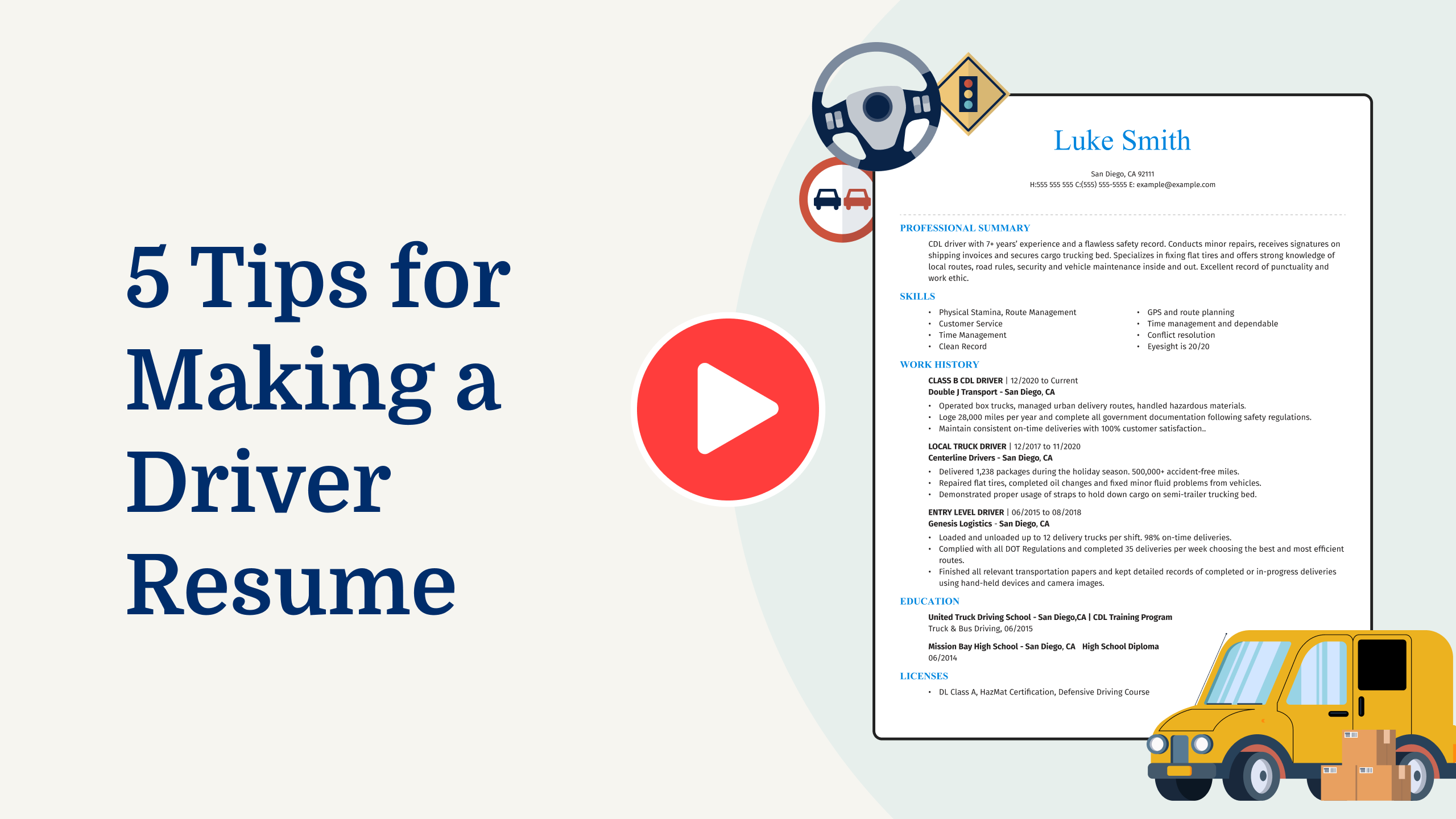
Write a strong professional summary
A professional summary on a resume serves as an introduction for hiring managers, providing a snapshot of your skills and accomplishments. You can decide whether to use a summary or a resume objective based on your experience level and career goals.
A professional summary is a short section highlighting your experience, skills, and notable achievements in three to four sentences. It works best for those with significant work history, showcasing their professional identity and the value they bring to the job. For someone in driving roles, this might highlight years of safe driving records and successful logistics management.
In contrast, resume objectives focus on career goals and are ideal for entry-level applicants, career changers, or those returning to the workforce after a gap. While a summary emphasizes “what I’ve accomplished,” an objective focuses on “what I aim to contribute.”
Next, we will provide examples of both summaries and objectives tailored to various industries and experience levels to show their effective use. Explore our library of resume examples for additional inspiration.
Driving resume summary examples
Entry-level
Recent graduate with a commercial driver’s license (CDL) and a clean driving record. Completed coursework in vehicle maintenance, safety regulations, and defensive driving techniques. Skilled in GPS navigation, route planning, and basic vehicle troubleshooting. Eager to apply a strong work ethic and dedication to ensuring timely deliveries and customer satisfaction.
Mid-career
Experienced driver with over 7 years in the transportation industry, specializing in long-haul trucking and local delivery routes. Proven track record of maintaining high safety standards and on-time delivery rates. Holds endorsements for hazardous materials (HazMat) and doubles/triples trailers. Known for excellent problem-solving skills, reliability, and a strong customer service focus.
Experienced
Seasoned professional driver with 15+ years of experience in the logistics sector, including fleet management and training new drivers. Expertise in operating various types of heavy vehicles, optimizing delivery schedules, and adhering to compliance requirements. Certified by the National Safety Council as a Defensive Driving Instructor. Recognized for leadership capabilities, superior route efficiency, and commitment to safety excellence.
Driving resume objective examples
Entry-level
Energetic and reliable individual seeking an entry-level driver position to leverage a clean driving record and strong navigational skills. Eager to contribute to a team-oriented company by ensuring timely deliveries and excellent customer service.
Career changer
Detail-oriented professional transitioning into the driving field, bringing strong organizational skills and a commitment to safety from previous roles in logistics. Looking forward to applying these abilities as a driver while providing dependable transportation solutions.
Recent graduate
Dedicated recent high school graduate aiming to start a career as a driver. Possesses knowledge of local routes and traffic regulations, with a focus on punctuality and maintaining vehicle upkeep. Aspires to support company operations through efficient delivery services.
Build a standout resume fast with our Resume Builder. Choose a design you like, fill in your details, and get ready to impress future employers.
Include relevant certifications and training
If you’re looking to stand out in a driving job, listing certifications and training is key. These credentials show that you have the necessary skills and knowledge to do the job safely and effectively.
For technical roles, having specific licenses or certifications can show employers that you know how to handle equipment or situations others might not be trained for. Creating a dedicated certifications section on your resume makes it easy for employers to see these important qualifications. Here are some examples of certifications to include on a driving resume:
- Commercial Driver’s License (CDL)
- Defensive Driving Course Certification
- First Aid and CPR Certification
- HAZMAT Endorsement Certification
- Passenger Transport Endorsement
Having these certifications can make you more attractive to potential employers by showing you’re ready for the job. They also help prove your commitment to safety and professionalism in driving roles. Make sure these are listed prominently on your resume so hiring managers can easily see your qualifications.
Example of a certifications section
Commercial Driver’s License (CDL)
Issued by: Department of Motor Vehicles
Issued 2022
Hazardous Materials Endorsement (HME)
Issued by: Transportation Security Administration (TSA)
Expires 2025
Passenger Transport Endorsement
Issued by: Department of Transportation
Issued 2021
Forklift Operator Certification
Issued by: Occupational Safety and Health Administration (OSHA)
Expires 2023
Defensive Driving Certification
Issued by: National Safety Council (NSC)
Issued 2019
Choose a polished and well-organized resume template that effectively showcases your skills and qualifications to stand out to hiring managers in your field.
Showcase your work experience
When applying for a driving job, showcasing your work experience is key. It shows employers you have the skills and know-how to do the job well. Start by listing your work experience in reverse chronological order. This means you should start with your most recent job and work backward. Include the job title, employer name, location, and employment dates for each role.
Using clear, action-oriented words will help make your duties and achievements stand out. Highlight what you’ve accomplished in previous driving jobs with measurable results.
Instead of just saying you delivered goods, mention how many packages you delivered per day or how you improved delivery times by a certain percentage. This kind of detail shows potential employers you’re effective and reliable. Be sure to include core responsibilities like safely operating vehicles, planning efficient routes, or maintaining accurate logs.
Actionable examples like “reduced delivery time by 20% through optimized route planning” can make a difference. By focusing on these aspects, you’ll present yourself as a strong applicant who understands what it takes to succeed in a driving role. Remember, the goal is to give a clear picture of your past experiences while demonstrating how they make you suited for the job you’re applying for now.
5 driving work history bullet points
- Navigated urban and rural routes efficiently, reducing delivery times by 15% while maintaining a perfect safety record.
- Trained 10 new drivers on company protocols, resulting in a 20% improvement in team performance within the first month.
- Implemented a vehicle maintenance program that decreased breakdown incidents by 25%, improving fleet reliability.
- Achieved a customer satisfaction score of 98% through timely deliveries and professional communication.
- Coordinated daily schedules for a team of 8 drivers, optimizing route planning to increase delivery capacity by 30%.
Choose a resume format that highlights punctuality, safe driving records, and customer satisfaction for driving positions.
Match your resume with the job description
Tailoring resumes to job descriptions is key because it helps job seekers stand out to employers and pass through applicant tracking systems (ATS). ATS software scans resumes for specific keywords from job postings, so matching your resume to the job description boosts your chances of getting noticed.
An ATS-friendly resume includes keywords and phrases relevant to the job. By aligning these terms with your skills and experiences, you increase the likelihood of hiring managers noticing your application.
To find these keywords, check the job posting for repeated skills, qualifications, and duties. For example, if a driving position mentions “safe driving,” “route planning,” or “vehicle maintenance” multiple times, use these exact phrases in your resume.
Incorporate these terms naturally by integrating them into your work history or skills section. Instead of copying directly from the description, rephrase it like this: change “Ensures safe driving practices” to “Applied safe driving practices daily.”
Targeted resumes that align with job descriptions not only improve ATS compatibility but also showcase how well-suited you are for the role. Make sure to customize your resume for each application to highlight relevant skills and experiences effectively.
Try our ATS Resume Checker to find more than 30 potential issues with your resume’s format and details. Get quick tips on how to raise your resume score.
FAQ
Do I need to include a cover letter with my driving resume?
Yes, adding a cover letter to your driving resume can help you stand out to potential employers. A cover letter gives you the chance to highlight your experience and showcase specific skills like safe driving records or knowledge of local routes that match the job.
For example, if the company specializes in transporting hazardous materials or has a unique logistics approach, mentioning any relevant certifications or experiences can boost your application.
You might consider using tools like our Cover Letter Generator to create one tailored to your resume or craft an entirely new one with expert advice along the way.
Additionally, exploring cover letter examples from various industries can offer inspiration and guidance on effectively structuring your cover letter for maximum impact.
How long should a driving resume be?
For a driving role, a one-page resume is typically sufficient to showcase your skills and experience effectively. Focus on key areas like your driving record, any special licenses or certifications you hold (like CDL), customer service skills, and familiarity with navigation tools or vehicle maintenance.
If you have extensive experience or specialized qualifications that set you apart, a two-page resume might be appropriate. Just ensure every detail included directly relates to the driving position you’re targeting, emphasizing recent roles and achievements.
Explore our guide on how long a resume should be for examples and tips on determining the ideal length for your career stage.
How do you write a driving resume with no experience?
If you’re putting together a resume with no experience for a driving position, emphasize your skills, relevant education, and related activities that demonstrate your potential for the role.
- Emphasize transferable skills: Highlight abilities such as attention to detail, time management, and reliability. Mention any experiences where you’ve demonstrated these skills, like managing a schedule or being responsible for tasks.
- Include relevant training or certifications: If you have completed a driver’s education course or obtained your driver’s license, list this prominently. Any special certifications for larger vehicles should also be included.
- Leverage volunteer or personal experiences: If you’ve driven for community events or helped family members by running errands regularly, include these experiences. Describe how they developed your driving skills and responsibility.
- Mention familiarity with local areas: If applicable, discuss your knowledge of local routes, which can be an asset for delivery or chauffeur roles.
By focusing on these elements, you can craft a resume that highlights your potential as a safe and dependable driver.
Rate this article
Driving
Additional Resources
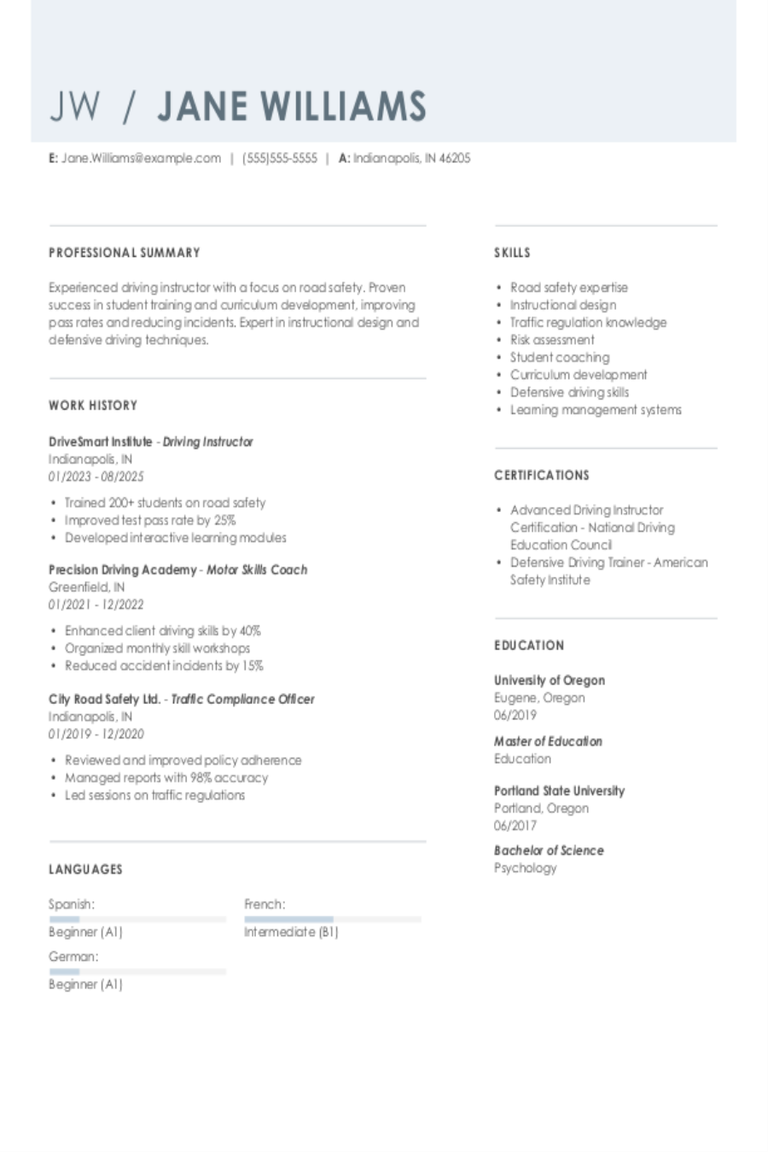
Driving Instructor Resume Examples & Templates for 2025
Explore driving instructor resumes to see how to highlight your experience teaching safe driving, planning lessons, and guiding new drivers. These examples and tips help you spotlight teaching skills and
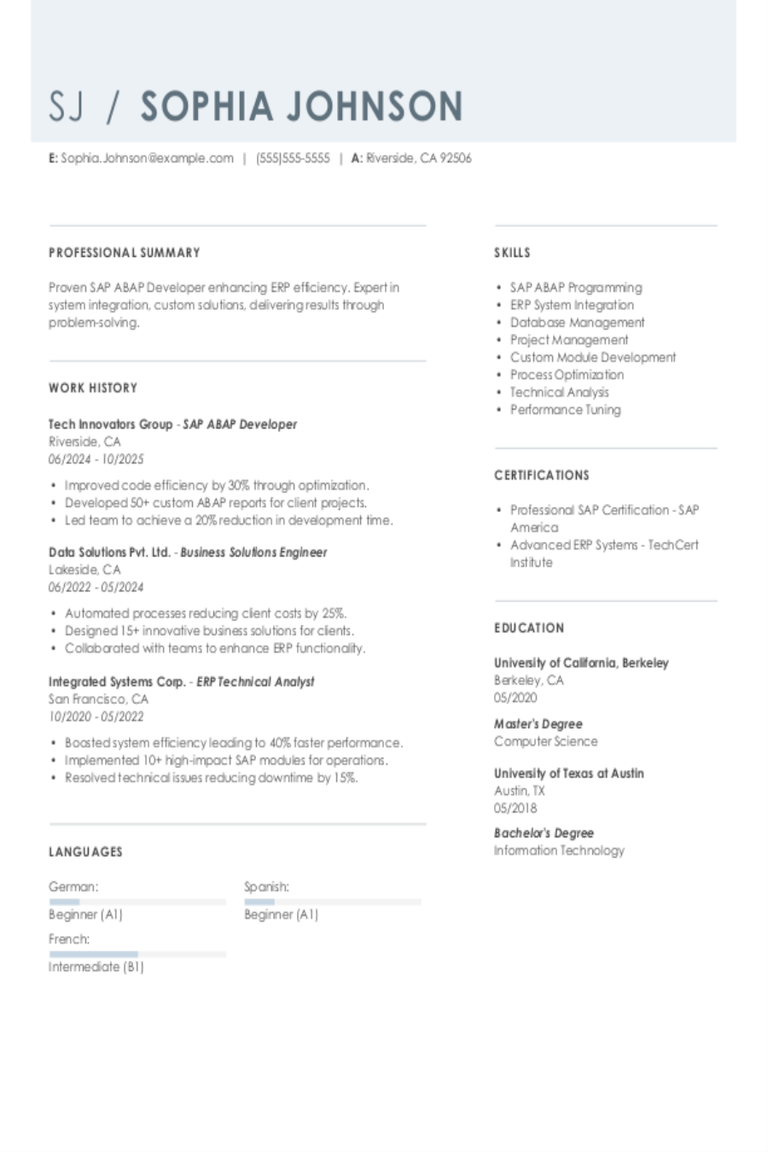
SAP ABAP Developer Resume Examples & Templates for 2025
Explore SAP ABAP developer resume examples and tips to learn how to spotlight your skills in coding, debugging, and system enhancements to stand out to hiring managers.Build my resumeImport existing
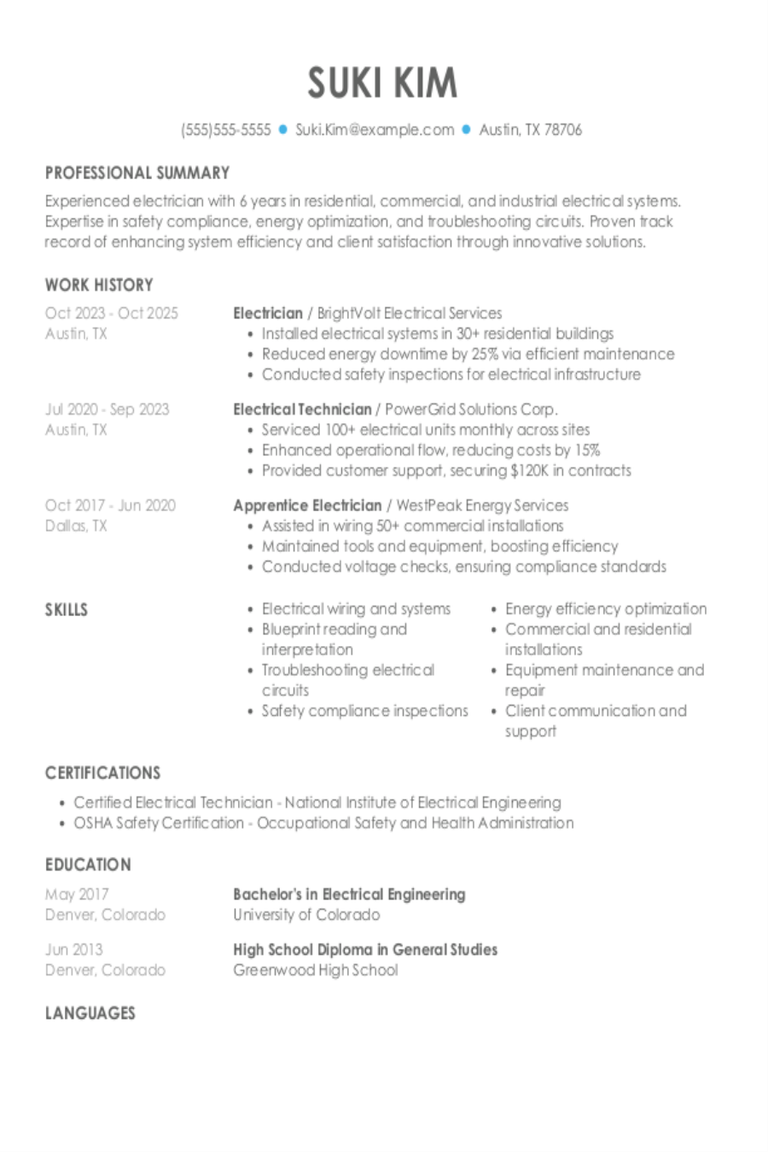
Electrician Resume Examples & Templates for 2025
Explore electrician resume examples to learn how to spotlight your wiring, troubleshooting, and safety skills. See how to emphasize your knowledge of electrical codes and highlight your experience across various
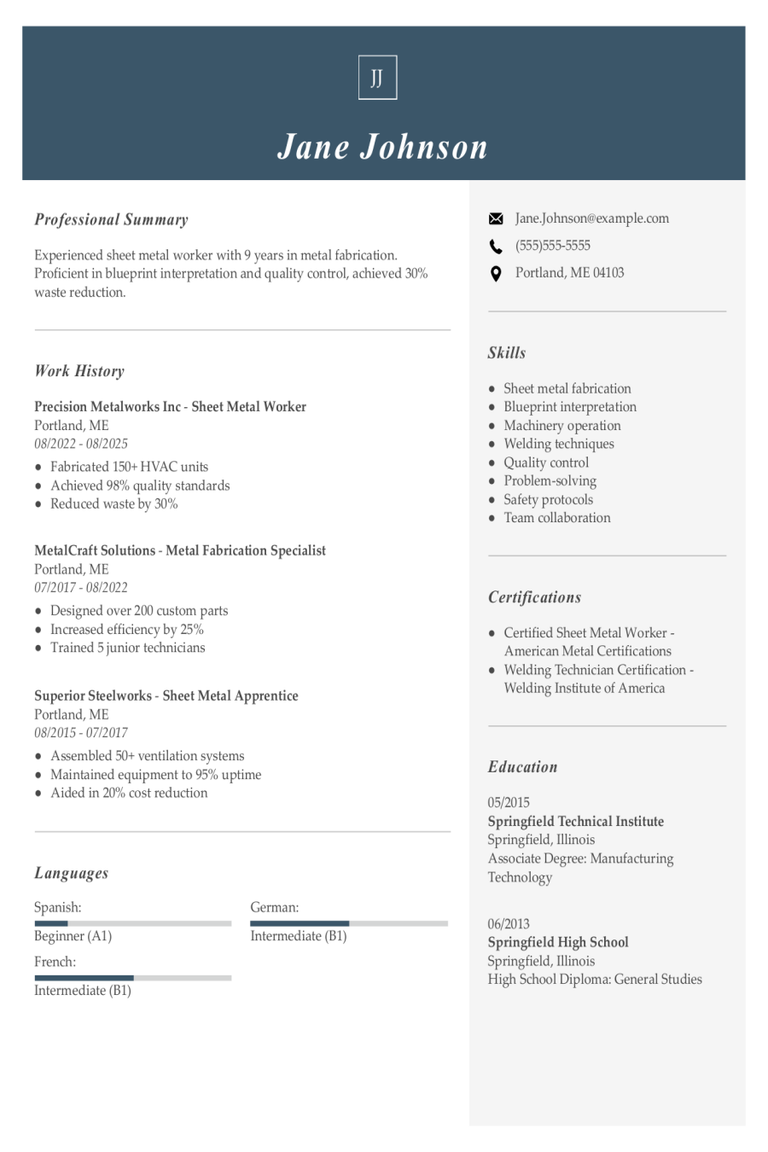
Sheet Metal Worker Resume Examples & Templates for 2025
Browse sheet metal worker resume examples and tips to learn how to highlight your hands-on experience and problem-solving abilities to stand out to recruiters and hiring managers.Build my resumeImport existing
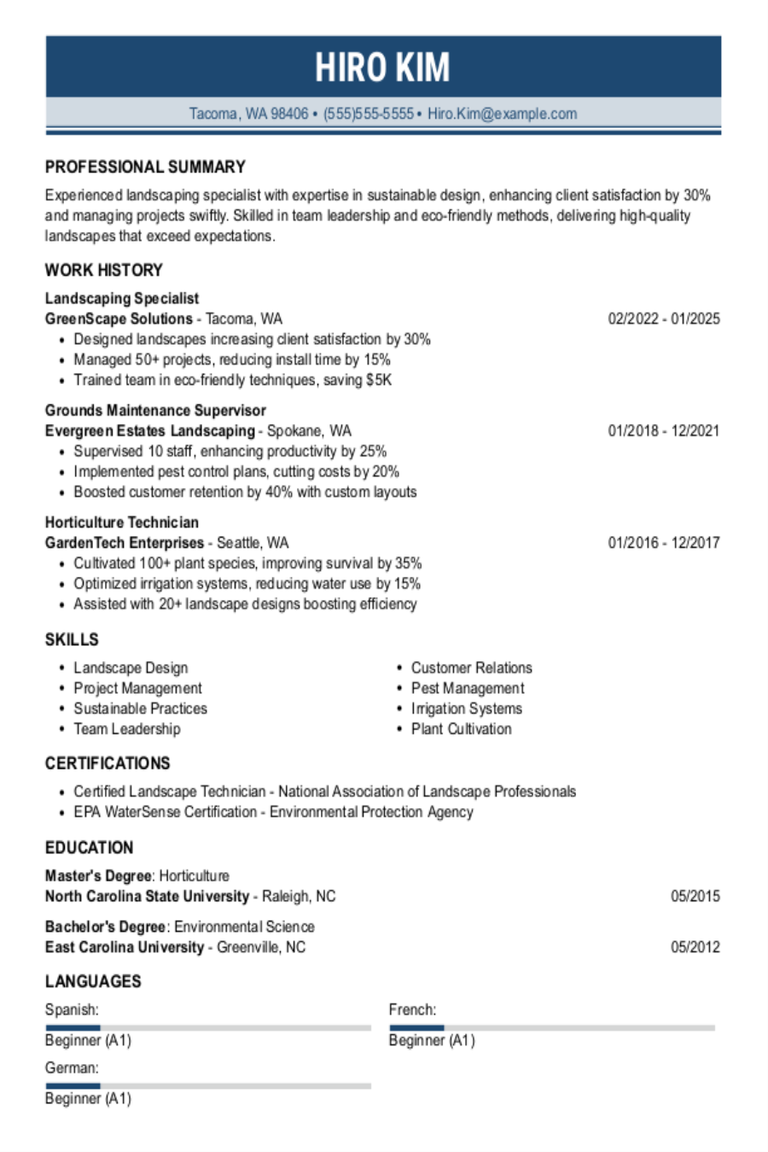
Landscaping Resume Examples & Templates for 2025
Explore landscaping resume examples to see how to showcase your gardening and design skills. Learn how to highlight your experience with plants, tools, and outdoor projects to catch the eye

